Whindersson Nunes demonstrou mais uma vez seu coração generoso ao promover uma emocionante iniciativa em prol da jovem Thayla Janis Carvalho Figueiredo, de apenas 9 anos, que recentemente alcançou os holofotes ao descobrir um asteroide. A notícia encantou o país, ressaltando não apenas a precocidade e o talento da garotinha, mas também a nobreza de gestos como o de Whindersson.
Thayla, natural do Piauí, revelou sua aptidão para a astronomia durante sua participação em um programa da NASA no ano passado, onde teve sua descoberta de um asteroide reconhecida pela renomada Agência Espacial Americana. Desde então, seu brilho só tem aumentado, com mais de 13 novas descobertas em seu currículo.
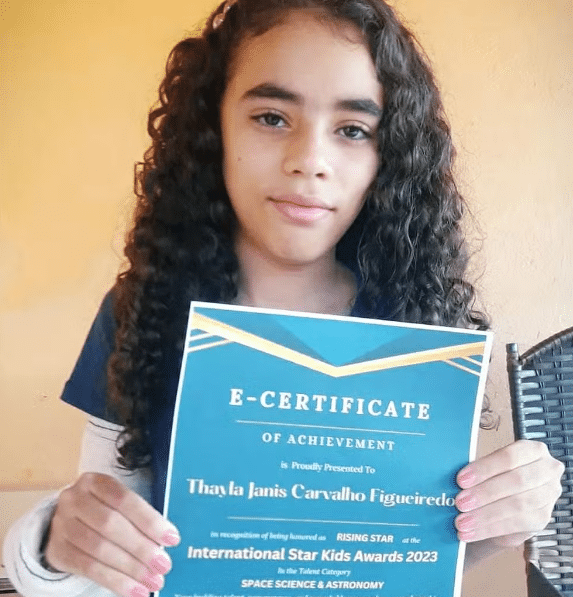
O humorista e empresário não só reconheceu o potencial de Thayla, mas também decidiu agir. “Para você estudar, fazer suas pesquisas e olhar para o céu como você gosta”, expressou Whindersson em uma postagem emocionante no Instagram, anunciando sua decisão de presentear a jovem com um telescópio.
Segundo o CRN, Whindersson também estendeu um convite especial a Thayla para testar um novo telescópio desenvolvido pela empresa da qual é sócio, a Tron Robótica Educativa. “A Tron Robótica Educativa estava projetando um telescópio simples de Busca Inteligente, queria que você fosse a primeira a testar na sede da Tron em Parnaíba”, revelou o influenciador.
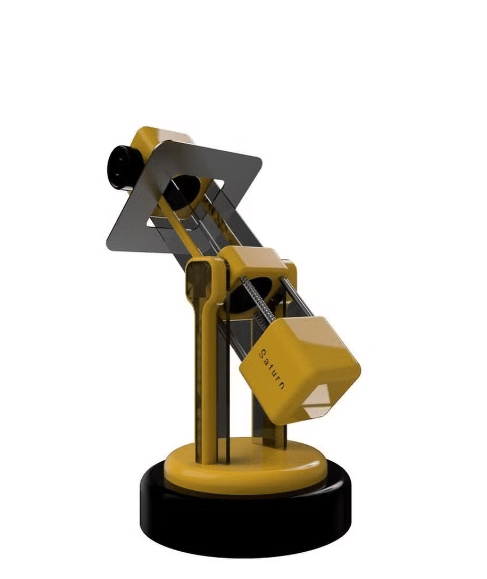
A homenagem não parou por aí. O telescópio, construído pela Tron, receberá o nome de “Saturn versão Janis 1”, em reconhecimento ao talento e à dedicação de Thayla à astronomia.
Emocionada com o gesto de apoio, Thayla expressou sua gratidão: “Agora eu vou poder observar o céu com minhas próprias pesquisas. Obrigado Whindersson Nunes e Tron, eu estou muito feliz”.
The post Whindersson Nunes doará telescópio para piauiense de 9 anos que descobriu asteroide appeared first on CONTI outra.
No auge dos seus 102 anos, Martha Zequetto Treco, residente do Brasil, foi surpreendida com uma notificação abrupta e desanimadora: seu plano de saúde, do qual é beneficiária desde 2009, estava prestes a ser cancelado unilateralmente pela operadora Unimed Nacional.
O comunicado, enviado pela administradora de benefícios Qualicorp, deixou seu filho, João Treco Filho, perplexo. Ele relata: “Sempre pagamos pontualmente o convênio médico. De uns anos para cá, ele passou a nos aterrorizar, com reajustes abusivos. Depois, descredenciou os principais hospitais que utilizávamos. Agora, simplesmente decidiu descredenciá-la”.

Martha, além de enfrentar os desafios da idade avançada, luta contra uma infecção bacteriana resistente, adquirida durante uma internação hospitalar, e investiga uma suspeita de tumor de mama. Seu tratamento requer cuidados específicos, incluindo antibióticos intravenosos, e sua mobilidade é comprometida.
Os esforços de Treco Filho para reverter a situação foram em vão. Ele conta: “A Qualicorp disse que não tinha o que fazer, que era uma decisão da Unimed. E a Unimed alegou ter direito a rescindir o contrato. Não ofereceram nenhum plano alternativo”.
Porém, após a intervenção da imprensa e a obtenção de uma liminar na Justiça, o plano de Martha foi temporariamente mantido. A Unimed Nacional declarou que cumpre rigorosamente a legislação e que as rescisões de planos coletivos estão previstas e regulamentadas pela ANS.

No entanto, casos como o de Martha têm se tornado mais frequentes, com um aumento significativo nas queixas à ANS sobre o cancelamento de planos coletivos por adesão. Advogados especializados em direito à saúde relatam um aumento na procura por assistência jurídica nesse sentido.
A advogada Marina Magalhães, do Idec, argumenta para a Folha de S. Paulo que a rescisão unilateral e imotivada é abusiva e fere os princípios da boa-fé nos contratos. Ela enfatiza a necessidade de uma regulamentação mais eficaz por parte da ANS ou do Legislativo.
O caso lança luz sobre uma questão premente no sistema de saúde brasileiro e levanta questões sobre os direitos dos consumidores e a necessidade de uma revisão nas políticas regulatórias do setor.
The post Idosa de 102 anos tem plano de saúde cancelado unilateralmente appeared first on CONTI outra.

Even among non-neuroscientists, determining the origin and purpose of consciousness is widely known as “the hard problem.” Since its coinage by philosopher David Chalmers thirty years ago, that label has worked its way into a variety of contexts; about a decade ago, Tom Stoppard even used it for the title of a play. Unsurprisingly, it’s also referenced in the episode of Big Think’s Dispatches from the Well above, which presents discussions of the nature of consciousness with neuroscientist Christof Koch, Vedanta Society of New York minister Swami Sarvapriyananda, technology entrepreneur Reid Hoffman, Santa Fe Institute Davis Professor of Complexity Melanie Mitchell, and mathematical physicist Roger Penrose.
Koch describes consciousness as “what you see, it’s what you hear, it’s the pains you have, the love you have, the fear, the passion.” It is, in other words, “the experience of anything,” and for all their sophistication, our modern inquiries into it descend from René Descartes’ proposition, “Cogito, ergo sum.” Sarvapriyananda, too, makes reference to Descartes in explaining his own conception of consciousness as “the light of lights,” by which “everything here is lit up.”
Mitchell conceives of it as a continuum: “I’m more conscious when I’m awake,” for example, and “certain species are more conscious than other species.” And perhaps it could develop even in non-biological entities: “I don’t think that we have any machines that are conscious in any interesting sense yet,” Mitchell says, but “if we ever do, they’ll be part of that spectrum.”
The question of whether a machine can attain consciousness naturally arises in host Kmele Foster’s conversation with Hoffman, who’s made serious investments in artificial-intelligence research. As impressive as AI chatbots have lately become, few among us would be willing to deem them conscious; nevertheless, attempting to create not just intelligence but consciousness in machines may prove a fruitful way to learn about the workings of the “genuine articles” within us. Penrose’s theory holds that consciousness arises from as-yet-unpredictable quantum processes occurring in the microtubules of the brain. Perhaps, as Koch has suggested, it actually exists to one degree or another in all forms of matter. Or maybe — to quote from a song in heavy rotation on my childhood Walkman — it’s just what you make of yourself.
Related content:
The Neuronal Basis of Consciousness Course: A Free Online Course from Caltech
John Searle Makes A Forceful Case for Studying Consciousness, Where Everything Else Begins
The Simulation Theory Explained In Three Animated Videos
Based in Seoul, Colin Marshall writes and broadcasts on cities, language, and culture. His projects include the Substack newsletter Books on Cities, the book The Stateless City: a Walk through 21st-Century Los Angeles and the video series The City in Cinema. Follow him on Twitter at @colinmarshall or on Facebook.

?si=RFbzFSzSNWzua3‑7
Could you use a mental escape? Maybe a trip to Mars will do the trick. Above, you can find high definition footage captured by NASA’s three Mars rovers–Spirit, Opportunity and Curiosity. The footage (also contributed by JPL-Caltech, MSSS, Cornell University and ASU) was stitched together by ElderFox Documentaries, creating what they call the most lifelike experience of being on Mars. Adding more context, Elder Fox notes:
The footage, captured directly by NASA’s Mars rovers — Spirit, Opportunity, Curiosity, and Perseverance — unveils the red planet’s intricate details. These rovers, acting as robotic geologists, have traversed varied terrains, from ancient lake beds to towering mountains, uncovering Mars’ complex geological history.
As viewers enjoy these images, they will notice informal place names assigned by NASA’s team, providing context to the Martian features observed. Each rover’s unique journey is highlighted, showcasing their contributions to Martian exploration.
Safe travels.
If you would like to sign up for Open Culture’s free email newsletter, please find it here. Or follow our posts on Threads, Facebook, BlueSky or Mastodon.
If you would like to support the mission of Open Culture, consider making a donation to our site. It’s hard to rely 100% on ads, and your contributions will help us continue providing the best free cultural and educational materials to learners everywhere. You can contribute through PayPal, Patreon, and Venmo (@openculture). Thanks!
Related Content:
Behold Colorful Geologic Maps of Mars Released by The United States Geological Survey
Carl Sagan Presents Six Lectures on Earth, Mars & Our Solar System … For Kids (1977)
Hear the Very First Sounds Ever Recorded on Mars, Courtesy of NASA
There was a time in America, not so very long ago, when conventional wisdom discouraged immigrants from speaking the language of the old country at home. In fact, “it used to be thought that being bilingual was a bad thing, that it would confuse or hold people back, especially children. Turns out we couldn’t have been more wrong.” These words are spoken by one of the variety of multilingual narrators of the recent BBC Ideas video above, which explains “why being bilingual is good for your brain” — not just if you pick up a second language in childhood, but also, and differently, if you deliberately study it as an adult.
“Learning a new language is an exercise of the mind,” says Li Wei of the Institute of Education at University College London. “It’s the mental equivalent of going to a gym every day.” In the bilingual brain, “all our languages are active, all at the same time.” (This we hear simultaneously in English and the professor’s native Mandarin.) “The continual effort of suppressing a language when speaking another, along with the mental challenge that comes with regularly switching between languages, exercises our brain. It improves our concentration, problem-solving, memory, and in turn, our creativity.”
In this century, some of the key discoveries about the benefits of bilingualism owe to the research of York University cognitive scientist Ellen Bialystok and her collaborators. Speaking a foreign language, she explains in this Guardian interview, requires using the brain’s “executive control system, whose job it is to resolve competition and focus attention. If you’re bilingual, you are using this system all the time, and that enhances and fortifies it.” In one study, she and her team found that bilinguals with advanced Alzheimer’s could function at the same cognitive levels with milder degrees of the same condition. “That’s the advantage: they could cope with the disease better.”
Mastering a foreign language is, of course, an aspiration commonly held but seldom realized. Based on personal experience, I can say that nothing does the trick quite like moving to a foreign country. But even if you’d rather not pull up stakes, you can benefit from the fact that the internet now provides the greatest, most accessible abundance of language-learning resources and tools humanity has ever known — an abundance you can start exploring right here at Open Culture. If it feels overwhelming to choose just one foreign language from this world of possibilities, feel free to use my system: study seven of them, one for each day of the week. Now, if you’ll excuse me, it’s Tuesday, which means I’ve got some français à apprendre.
Related content:
Learn 48 Languages Online for Free: Spanish, Chinese, English & More
Becoming Bilingual Can Give Your Brain a Boost: What Recent Research Has to Say
A Map Showing How Much Time It Takes to Learn Foreign Languages: From Easiest to Hardest
Why You Have an Accent When You Speak a Foreign Language
Meet the Hyperpolyglots, the People Who Can Mysteriously Speak Up to 32 Different Languages
Based in Seoul, Colin Marshall writes and broadcasts on cities, language, and culture. His projects include the Substack newsletter Books on Cities, the book The Stateless City: a Walk through 21st-Century Los Angeles and the video series The City in Cinema. Follow him on Twitter at @colinmarshall or on Facebook.
Things change…
Especially when you’re tracking the continental movement from Pangea to the present day in 5 million years increments at the rate of 2.5 million years per second.
Wherever you are, 350 million years ago, your address would’ve been located on the mega-continent of Pangea.
Here’s a map of what things looked like back then.
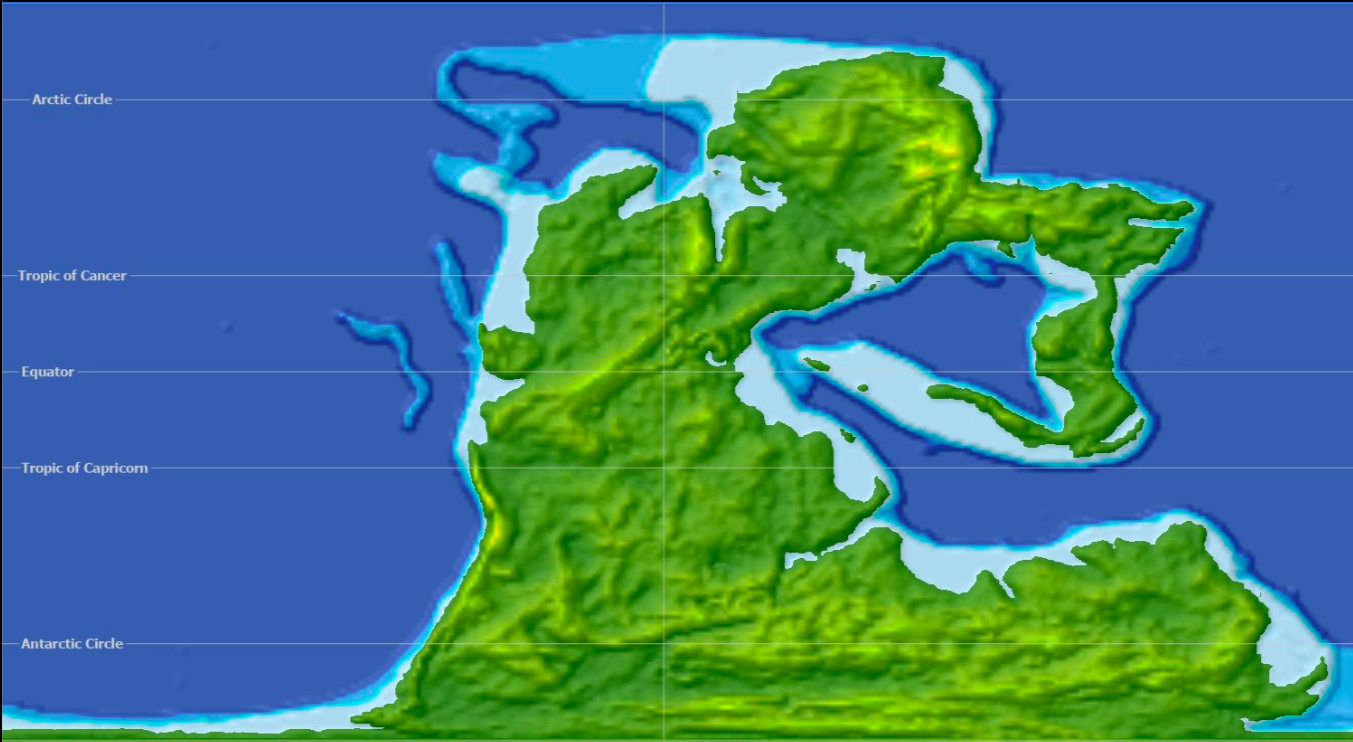
Those who’ve grown a bit fuzzy on their geography may require some indications of where future landmasses formed when Pangea broke apart. Your map apps can’t help you here.

The first split occurred in the middle of the Jurassic period, resulting in two hemispheres, Laurasia to the north and Gondwana.
As the project’s story map notes, 175 million years ago Africa and South America already bore a resemblance to their modern day configurations.
North America, Asia, and Europe needed to stay in the oven a bit longer, their familiar shapes beginning to emerge between 150 and 120 million years ago.
India peeled off from its “mother” continent of Gondwana some 100 million years ago.
Its tectonic plate collided with the Eurasian Plate, giving rise to the Himalayas and the Tibetan Plateau, by which point, dinosaurs had been extinct for about 15 million years…)
Geography nerds may chafe at the seemingly inaccurate sizes of Greenland, Antarctica and Australia. Rest assured that the mapmakers are aware, chalking it to the “distortion of the cartographic projection that exaggerates areas close to the Poles.”
Just for fun, let’s run it backwards!
But enough of the past. What of the future?
Those who really want to know could jump ahead to the end of the story map to see PALEOMAP Project founder Christopher Scotese’s speculative configuration of earth 250 million years hence, should current tectonic plate motion trends continue.
Behold his vision of mega-continent, Pangea Proxima, a landmass “formed from all current continents, with an apparent exception of New Zealand, which remains a bit on the side:”
On the opposite side of the world, North America is trying to fit to Africa, but it seems like it does not have the right shape. It will probably need more time…
Not to bum you out, but a more recent study paints a grimmer picture of a coming supercontinent, Pangea Ultima, when extreme temperatures have rendered just 8 percent of Earth’s surface hospitable to mammals, should they survive at all.
As the study’s co-author, climatologist Alexander Farnsworth, told Nature News, humans might do well to get “off this planet and find somewhere more habitable.”

Related Content
Map Showing Where Today’s Countries Would Be Located on Pangea
– Ayun Halliday is the Chief Primatologist of the East Village Inky zine and author, most recently, of Creative, Not Famous: The Small Potato Manifesto and Creative, Not Famous Activity Book. Follow her @AyunHalliday.

For a variety of reasons, science fiction has long been regarded as a mostly male-oriented realm of literature. This is evidenced, in part, by the eagerness to celebrate particular works of sci-fi written by women, like Ursula K. LeGuin’s Earthsea saga, Octavia Butler’s Parable novels, Joanna Russ’ The Female Man, or Margaret Attwood’s The Handmaid’s Tale (uneasily though it fits within the boundaries of the genre). But those who prefer the early stuff can go all the way back to the mid-seventeenth century, where they’ll find Margaret Cavendish’s The Blazing World, readable and downloadable in all its strange glory free online.
“The Blazing World was first published in 1666 and is often considered a forerunner to both science fiction and the utopian novel genres,” writes book blogger Eric Karl Anderson. “It’s a totally bonkers story of a woman who is stolen away to the North Pole only to find herself in a strange bejeweled kingdom of which she becomes the supreme Empress. Here she consults with many different animal/insect people about philosophical, religious and scientific ideas. The second half of the book pulls off a meta-fictional trick where Cavendish (as the Duchess of Newcastle) enters the story herself to become the Empress’ scribe and close companion.”
In the video just below, Youtuber Great Books Prof frames this as not just a work of proto-science fiction, but also a pioneering use of the “multiverse” concept that has undergirded any number of twenty-first-century blockbusters.
The Blazing World continues to inspire: actor-director Carlson Young put out a loose cinematic adaptation just a few years ago. Cavendish herself described the book as a “hermaphroditic text,” possibly in reference to its engagement with topics then addressed almost exclusively by men. But it also occupied two categories at once in that she originally published it as a fictional section of her book Observations upon Experimental Philosophy, one of six philosophical volumes she wrote. In fact, her work qualified her as not just philosopher and novelist, but also scientist, poet, playwright, and even biographer. That last she accomplished by writing The Life of the Thrice Noble, High and Puissant Prince William Cavendish, who happened to be her husband. Let her life be a lesson to those young girls who simultaneously dream of becoming a princess and a writer whose books are read for centuries: sometimes, you can have it all.
Related content:
100 Great Sci-Fi Stories by Women Writers (Read 20 for Free Online)
The First Work of Science Fiction: Read Lucian’s 2nd-Century Space Travelogue A True Story
When Astronomer Johannes Kepler Wrote the First Work of Science Fiction, The Dream (1609)
The Encyclopedia of Science Fiction: 17,500 Entries on All Things Sci-Fi Are Now Free Online
Based in Seoul, Colin Marshall writes and broadcasts on cities, language, and culture. His projects include the Substack newsletter Books on Cities, the book The Stateless City: a Walk through 21st-Century Los Angeles and the video series The City in Cinema. Follow him on Twitter at @colinmarshall or on Facebook.
From Kurzgesagt comes the history of our planet in one hour. They write: “Earth is 4.5 billion years old — which is approximately the same amount of time it took us to create this video. We’ve scaled the complete timeline of our Earth’s life into our first animated movie! Every second shows about a million years of the planet’s evolution. Hop on a musical train ride and experience how long a billion years really is.” Below, you can find the timestamps for the geologic periods covered in the video.
0:00 Intro
0:51 Hadean
8:04 Eoarchean
13:20 Paleoarchean
18:35 Mesoarchean
23:51 Neoarchean
27:47 Siderian
30:24 Rhyacian
33:42 Orosirian
36:58 Statherian
39:38 Calymmian
42:15 Ectasian
44:52 Stenian
47:30 Tonian
51:12 Cryogenian
52:18 Ediacaran
53:35 Cambrian
54:17 Ordovician
54:49 Silurian
55:08 Devonian
55:55 Carboniferous
56:43 Permian
57:21 Triassic
58:02 Jurassic
58:46 Cretaceous
59:48 Paleogene
1:00:21 Neogene
1:00:38 Quaternary
1:00:45 Ending
If you would like to sign up for Open Culture’s free email newsletter, please find it here. Or follow our posts on Threads, Facebook, BlueSky or Mastodon.
If you would like to support the mission of Open Culture, consider making a donation to our site. It’s hard to rely 100% on ads, and your contributions will help us continue providing the best free cultural and educational materials to learners everywhere. You can contribute through PayPal, Patreon, and Venmo (@openculture). Thanks!
As Lisa Simpson once memorably remarked, “I can see the music.”
Pretty much anyone can these days.
Just switch on your device’s audio visualizer.
That wasn’t the case in the 1940s, when psychologist Cecil A. Stokes used chemistry and polarized light to invent soothing abstract music videos, a sort of cinematic synesthesia experiment such as can be seen above, in his only known surviving Auroratone.
(The name was suggested by Stokes’ acquaintance, geologist, Arctic explorer and Catholic priest, Bernard R. Hubbard, who found the result reminiscent of the Aurora Borealis.)
The trippy visuals may strike you as a bit of an odd fit with Bing Crosby‘s cover of the sentimental crowdpleaser “Oh Promise Me,” but traumatized WWII vets felt differently.
Army psychologists Herbert E. Rubin and Elias Katz’s research showed that Auroratone films had a therapeutic effect on their patients, including deep relaxation and emotional release.
The music surely contributed to this positive outcome. Other Auroratone films featured “Moonlight Sonata,” “Clair de Lune,” and an organ solo of “I Dream of Jeannie with the Light Brown Hair.”
Drs. Rubin and Katz reported that patients reliably wept during Auroratones set to “The Lost Chord,” “Ave Maria,” and “Home on the Range” – another Crosby number.
In fact, Crosby, always a champion of technology, contributed recordings for a full third of the fifteen known Auroratones free of charge and footed the bill for overseas shipping so the films could be shown to soldiers on active duty and medical leave.
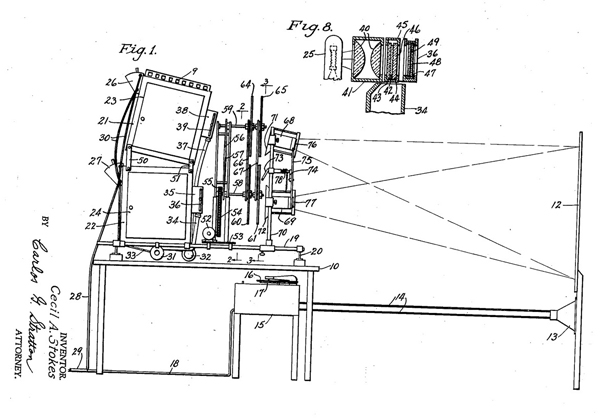
Technophile Crosby was well positioned to understand Stokes’ patented process and apparatus for producing musical rhythm in color – aka Auroratones – but those of us with a shakier grasp of STEM will appreciate light artist John Sonderegger’s explanation of the process, as quoted in filmmaker and media conservator Walter Forsberg’s history of Auroratones for INCITE Journal of Experimental Media:
[Stokes’] procedure was to cut a tape recorded melody into short segments and splice the resulting pieces into tape loops. The audio signal from the first loop was sent to a radio transmitter. The radio waves from the radio transmitter were confined to a tube and focused up through a glass slide on which he had placed a chemical mixture. The radio waves would interact with the solution and trigger the formation of the crystals. In this way each slide would develop a shape interpretive of the loop of music it had been exposed to. Each loop, in sequence, would be converted to a slide. Eventually a set of slides would be completed that was the natural interpretation of the complete musical melody.
Vets suffering from PTSD were not the only ones to embrace these unlikely experimental films.
Patients diagnosed with other mental disorders, youthful offenders, individuals plagued by chronic migraines, and developmentally delayed elementary schoolers also benefited from Auroratones’ soothing effects.
The general public got a taste of the films in department store screenings hyped as “the nearest thing to the Aurora Borealis ever shown”, where the soporific effect of the color patterns were touted as having been created “by MOTHER NATURE HERSELF.”
Auroratones were also shown in church by canny Christian leaders eager to deploy any bells and whistles that might hold a modern flock’s attention.
The Guggenheim Museum‘s brass was vastly less impressed by the Auroratone Foundation of America’s attempts to enlist their support for this “new technique using non-objective art and musical compositions as a means of stimulating the human emotions in a manner so as to be of value to neuro-psychiatrists and psychologists, as well as to teachers and students of both objective and non-objective art.”
Co-founder Hilla Rebay, an abstract artist herself, wrote a letter in which she advised Stokes to “learn what is decoration, accident, intellectual confusion, pattern, symmetry… in art there is conceived law only –never an accident.”
A plan for projecting Auroratones in maternity wards to “do away with the pains of child-birth” appears to have been a similar non-starter.
While only one Auroratone is known to have survived – and its discovery by Robert Martens, curator of Grandpa’s Picture Party, is a fascinating tale unto itself – you can try cobbling together a 21st-century DIY approximation by plugging any of the below tunes into your preferred music playing software and turning on the visualizer:

via Boing Boing / INCITE
Related Content
How the 1968 Psychedelic Film Head Destroyed the Monkees & Became a Cult Classic
The Psychedelic Animated Video for Kraftwerk’s “Autobahn” (1979)
– Ayun Halliday is the Chief Primatologist of the East Village Inky zine and author, most recently, of Creative, Not Famous: The Small Potato Manifesto and Creative, Not Famous Activity Book. Follow her @AyunHalliday.

Image by The Wellcome Trust
When researching a famous historical figure, access to their work and materials usually proves to be one of the biggest obstacles. But things are much more difficult for those writing about the life of Marie Curie, the scientist who, along her with husband Pierre, discovered polonium and radium and birthed the idea of particle physics. Her notebooks, her clothing, her furniture (not to mention her lab), pretty much everything surviving from her Parisian suburban house, is radioactive, and will be for 1,500 years or more.
If you want to look at her manuscripts, you have to sign a liability waiver at France’s Bibliotheque Nationale, and then you can access the notes sealed in a lead-lined box. The Curies didn’t know about the dangers of radioactive materials, though they did know about radioactivity. Their research attempted to find out which substances were radioactive and why, and so many dangerous elements–thorium, uranium, plutonium–were just sitting there in their home laboratory, glowing at night, which Curie thought beautiful, “like faint, fairy lights,” she wrote in her autobiography. Marie Curie carried these glowing objects around in her pockets. She and her husband wore standard lab clothing, nothing more.
Marie Curie died at age 66 in 1934, from aplastic anemia, attributed to her radioactive research. The house, however, continued to be used up until 1978 by the Institute of Nuclear Physics of the Paris Faculty of Science and the Curie Foundation. After that it was kept under surveillance, authorities finally now aware of the dangers inside. When many people in the neighborhood noticed high cancer rates among them, as reported in Le Parisien, they blamed the Curie’s home.
The laboratory and the building were decontaminated in 1991, a year after the Curie estate began allowing access to Curie’s notes and materials, which had been removed from the house. A flood of biographies appeared soon after: Marie Curie: A Life by Susan Quinn in 1995, Pierre Curie by Anna Hurwic in 1998, Curie: Le rêve scientifique by Loïc Barbo in 1999, Marie Curie et son laboratoire by Soraya Boudia in 2001, Obsessive Genius: The Inner World of Marie Curie by Barbara Goldsmith in 2005, and Radioactive: Marie and Pierre Curie, a Tale of Love and Fallout by Lauren Redniss in 2011.
Still, passing away at 66 is not too shabby when one has changed the world in the name of science. Marie Curie was the first woman to win a Nobel Prize (1903), the only woman to win it again (1911), the first woman to become a professor at the University of Paris, and the first woman to be entombed (on her own merits) at the Panthéon in Paris. And she managed many of her breakthroughs after the passing of her husband Pierre in 1906–who slipped and fell in the rain on a busy Paris street and was run over by the wheels of a horse-drawn cart.
Note: An earlier version of this post appeared on our site in 2015.
Related Content:
An Animated Introduction to the Life & Work of Marie Curie, the First Female Nobel Laureate
An Animated Introduction to the Life & Work of Marie Curie, the First Female Nobel Laureate
Ted Mills is a freelance writer on the arts who currently hosts the FunkZone Podcast. You can also follow him on Twitter at @tedmills, read his other arts writing at tedmills.com and/or watch his films here.

Nature doesn’t care if you’re happy, but Yale psychology professor Laurie Santos does.
As Dr. Santos points out during the above appearance on The Well, the goals of natural selection have been achieved as long as humans survive and reproduce, but most of us crave something more to consider life worth living.
With depression rising to near epidemic levels on college campuses and elsewhere, it’s worth taking a look at our ingrained behavior, and maybe making some modifications to boost our happiness levels.
Psychology and the Good Life, Dr. Santos’ massive twice weekly lecture class that actively tackles ways of edging closer to happiness, is the most popular course in Yale’s more than 300-year history.
Do we detect some resistance?
Positive psychology – or the science of happiness – is a pretty crowded field lately, and the overwhelming demand created by great throngs of people longing to feel better has attracted a fair number of grifters willing to impart their proven methodologies to anyone enrolling in their paid online courses.
By contrast, Dr. Santos not only has that Yale pedigree, she also cites other respected academics such as the University of Chicago’s Nicholas Epley, a social cognition specialist who believes undersociality, or a lack of face-to-face engagement, is making people miserable, and Harvard’s Dan Gilbert and the University of Virginia’s Timothy Wilson, who co-authored a paper on “miswanting“, or the tendency to inaccurately predict what will truly result in satisfaction and happiness.
Yale undergrad Mickey Rose, who took Psychology and the Good Life in the spring of 2022 to fulfill a social science credit, told the Yale Daily News that her favorite part of the class was that “everything was cited, everything had a credible source and study to back it up:”
I’m a STEM major and it’s kind of my overall personality type to question claims that I find not very believable. Obviously the class made a lot of claims about money, grades, happiness, that are counterintuitive to most people and to Yale students especially.
With Psychology and the Good Life now available to the public for free on Coursera, even skeptics might consider giving Dr. Santos’ recommended “re-wirement practices” a peek, though be forewarned, you should be prepared to put them into practice before making pronouncements as to their efficacy.
It’s all pretty straightforward stuff, starting with “use your phone to actually be a phone”, meaning call a friend or family member to set up an in person get together rather than scrolling through endless social media feeds.
Other common sense adjustments include looking beyond yourself to help by volunteering, resolving to adopt a glass-is-half-full type attitude, cultivating mindfulness, making daily entries in a gratitude journal, and becoming less sedentary.
(You might also give Dr. Santos’ Happiness Lab podcast a go…)
Things to guard against are measuring your own happiness against the perceived happiness of others and “impact bias” – overestimating the duration and intensity of happiness that is the expected result of some hotly anticipated event, acquisition or change in social standing.
Below Dr. Santos gives a tour of the Good Life Center, an on-campus space that stressed out, socially anxious students can visit to get help putting some of those re-wirement practices into play.
Sign up for Coursera’s 10-week Science of Well-Being course here.
Related Content
The Science of Well-Being: Take a Free Online Version of Yale University’s Most Popular Course
Free Online Psychology & Neuroscience Courses, a subset of our collection, 1,700 Free Online Courses from Top Universities
What Are the Keys to Happiness? Lessons from a 75-Year-Long Harvard Study
– Ayun Halliday is the Chief Primatologist of the East Village Inky zine and author, most recently, of Creative, Not Famous: The Small Potato Manifesto and Creative, Not Famous Activity Book. Follow her @AyunHalliday.
A startup Precision Neuroscience adquiriu uma fábrica em Dallas, nos Estados Unidos. O anúncio ocorreu anunciou nesta quinta-feira (05). Segundo a concorrente da Neuralink, de Elon Musk, o local será utilizado para construção do componente-chave de seu implante cerebral, a Layer 7 Cortical Interface.
Leia mais

O conjunto de eletrodos da Precision é mais fino do que um cabelo humano. O design flexível permite que ele descanse na superfície do cérebro e gere uma renderização em tempo real e de alta resolução da atividade neural sem danificar nenhum tecido.
O produto da empresa se diferente de seu concorrente, a Neuralink. A companhia de Elon Musk adota uma abordagem mais invasiva nos testes com o seu implante.
Isso nos permite iterar muito rapidamente, melhorar o desempenho, a longevidade, os diferentes fatores de forma do dispositivo – todas as coisas que sempre quisemos fazer, agora podemos fazer em uma sucessão muito mais rápida.
Michael Mager, cofundador e CEO da Precision Neuroscience

A pedido do vendedor, uma multinacional japonesa, a Precision se recusou a compartilhar quanto custou a fábrica. Mager disse que a empresa conseguiu reter os 11 “funcionários-chave” que estavam trabalhando lá, e há uma possibilidade de que esse número cresça com o tempo. A manutenção dos trabalhadores significa que a empresa não precisa contratar e ensinar novos funcionários a lidar com a complexa tecnologia.
Segundo Mager, a compra do novo espaço potencializou a produção da empresa. Anteriormente, a Precision levou mais de um ano para fabricar seis matrizes e, agora, a pode fabricar mais de 100 unidades em apenas uma semana.
Acho que, em última análise, o valor que temos o potencial de criar é muito maior como resultado de estarmos no controle total e possuirmos 100% da instalação que está ajudando a impulsionar toda essa inovação. Mas é um jogo mais longo, mais intensivo em capital.
Michael Mager, cofundador e CEO da Precision Neuroscience
A Precision tem trabalhado em estreita colaboração com os reguladores, mas a empresa ainda precisa passar por várias rodadas de testes rigorosos de segurança e eficácia antes de receber a aprovação da Food and Drug Administration (FDA), a agência de regulação dos Estados Unidos, para comercializar sua tecnologia.
Mas mesmo esse processo avança rapidamente. A empresa recebeu nos últimos dias uma designação de dispositivo inovador da agência. Ela é concedida a dispositivos médicos que têm o potencial de fornecer tratamento aprimorado para condições debilitantes ou com risco de vida.
A designação abrirá uma linha de comunicação mais frequente entre a Precision e a FDA que ajudará a agilizar o caminho da empresa para a comercialização.
O post Concorrente da Neuralink compra fábrica para construir implantes cerebrais apareceu primeiro em Olhar Digital.
Todo mundo gosta de chocolate, não é? A doçura que ele oferece é irresistível para muitos. Mas o que você acharia se soubesse que, de acordo com a Food and Drugs Administration (FDA), a agência reguladora de alimentos dos Estados Unidos, cada barra de chocolate que você saboreia contém, em média, oito pedaços de baratas? A revelação pode parecer chocante, mas há mais a ser desvendado sobre essa surpreendente descoberta.
Segundo a FDA, essa presença de insetos não é exclusiva dos chocolates. Na verdade, todos os alimentos que consumimos possuem contaminantes naturais, e esses números são considerados normais pelas autoridades. No caso do chocolate, um produto de 100 gramas pode ser comercializado com até 60 pedaços de insetos, de acordo com as regulamentações. No entanto, é importante esclarecer que as baratas não são incluídas na lista de ingredientes do chocolate. Em vez disso, pequenos vestígios e partes de insetos podem ser moídos junto com o doce durante o processo de produção, o que pode afetar pessoas com alergias e asma.
Os possíveis efeitos colaterais de consumir alimentos com vestígios de insetos incluem dores de cabeça, coceira e urticária, o que pode tornar a experiência de desfrutar de um chocolate menos agradável para muitas pessoas. No entanto, é importante ressaltar que, para evitar completamente a presença de insetos em alimentos, os produtores teriam que recorrer ao uso intensivo de pesticidas, o que pode acarretar em riscos para a saúde humana e ambiental.

O alergista Morton M. Teich enfatiza que evitar completamente a ingestão de insetos na comida é praticamente impossível. Eles estão presentes em uma ampla variedade de alimentos, não apenas em chocolates, mas também em produtos como amendoim, macarrão, frutas e queijos. O Dr. Teich acredita que os riscos associados ao uso excessivo de pesticidas são muito maiores do que a possibilidade de consumir vestígios de insetos. Em suas palavras, “evitar insetos na comida é quase impossível. Você provavelmente teria que parar de comer completamente.”
Portanto, enquanto a ideia de pedaços de baratas em nosso chocolate pode parecer perturbadora, é importante entender que a presença de vestígios de insetos em nossos alimentos é uma realidade da qual é difícil escapar.
Com informações de Terra
The post Você sabia que chocolates contém pedaços de baratas e outros insetos? Saiba mais appeared first on CONTI outra.

Alex Woolner knows how to put a degree in English to good use.
Past projects include a feminist typewriter blog, retrofitting sticker vending machines to dispense poetry, and a free residency program for emerging artists at a multidisciplinary studio she co-founded with playwright and painter Jason Montgomery in Easthampton, Massachusetts.
More recently, the poet and international educator has combined her interest in amigurumi crocheted animals and ChatGPT, the open source AI chatbot.
Having crocheted an amigurumi narwhal for a nephew earlier this year, she hopped on ChatGPT and asked it to create “a crochet pattern for a narwhal stuffed animal using worsted weight yarn.”
The result might have discouraged another querent, but Woolner got out her crochet hook and sallied forth, following ChatGPTs instructions to the letter, despite a number of red flags indicating that the chatbot’s grasp of narwhal anatomy was highly unreliable.
Its ignorance is part of its DNA. As a large language model, ChatGPT is capable of producing predictive text based on vast amounts of data in its memory bank. But it can’t see images.
As Amit Katwala writes in Wired:
It has no idea what a cat looks like or even what crochet is. It simply connects words that frequently appear together in its training data. The result is superficially plausible passages of text that often fall apart when exposed to the scrutiny of an expert—what’s been called “fluent bullshit.”
It’s also not too hot at math, a skill set knitters and crocheters bring to bear reading patterns, which traffic in numbers of rows and stitches, indicated by abbreviations that really flummox a chatbot.
An example of beginner-level instructions from a free downloadable pattern for a cute amigurumi shark:
DORSAL FIN (gray yarn)
Rnd 1: in a mr work 3 sc, 2 hdc, 1 sc (6)
Rnd 2: 3 sc, 1 hdc inc, 1 hdc, 1 sc (7)
Rnd 3: 3 sc, 2 hdc, 1 hdc inc, 1 sc (8)
Rnd 4: 3 sc, 1 hdc inc, 3 hdc, 1 sc inc (10)
Rnd 5: 3 sc, 1 hdc, 1 hdc inc, 3 hdc, 1 sc, 1 sc inc (12)
Rnd 6: 3 sc, 6 hdc, 3 sc (12)
Rnd 7: sc even (12); F/O and leave a long strand of yarn to sew the dorsal fin between rnds # 18-23. Do not stuff the fin.
Pity poor ChatGPT, though, like Woolner, it tried.
Their collaboration became a cause célèbre when Woolner debuted the “AI generated narwhal crochet monstrosity” on TikTok, aptly comparing the large tusk ChatGPT had her position atop its head to a chef’s toque.
Is that the best AI can do?
A recent This American Life episode details how Sebastien Bubeck, a machine learning researcher at Microsoft, commanded another large language model, GPT-4, to create code that TikZ, a vector graphics producer, could use to “draw” a unicorn.
This collaborative experiment was perhaps more empirically successful than the ChatGPT amigurumi patterns Woolner dutifully rendered in yarn and fiberfill. This American Life’s David Kestenbaum was sufficiently awed by the resulting image to hazard a guess that “when people eventually write the history of this crazy moment we are in, they may include this unicorn.”
It’s not good, but it’s a fucking unicorn. The body is just an oval. It’s got four stupid rectangles for legs. But there are little squares for hooves. There’s a mane, an oval for the head. And on top of the head, a tiny yellow triangle, the horn. This is insane to say, but I felt like I was seeing inside its head. Like it had pieced together some idea of what a unicorn looked like and this was it.
Let’s not poo poo the merits of Woolner’s ongoing explorations though. As one commenter observed, it seems she’s “found a way to instantiate the weird messed up artifacts of AI generated images in the physical universe.”
To which Woolner responded that she “will either be spared or be one of the first to perish when AI takes over governance of us meat sacks.”


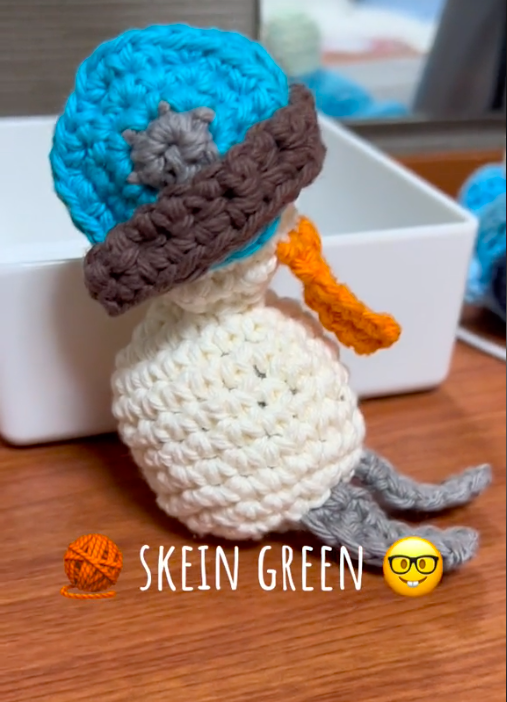
In the meantime, she’s continuing to harness ChatGPT to birth more monstrous amigurumi. Gerald the Narwhal’s has been joined by a cat, an otter, Norma the Normal Fish, XL the Newt, and Skein Green, a pelican bearing get well wishes for author and science vlogger Hank Green.
When retired mathematician Daina Taimina, author of Crocheting Adventures with Hyperbolic Planes, told the Daily Beast that Gerald would have resembled a narwhal more closely had Woolner supplied ChatGPT with more specifics, Woolner agreed to give it another go.
Two weeks later, the Daily Beast pronounced this attempt, nicknamed Gerard, “even less narwhal-looking than the first. Its body was a massive stuffed triangle, and its tusk looked like a gumdrop at one end.”

Woolner dubbed Gerard possibly the most frustrating AI-generated amigurumi of her acquaintance, owing to an onslaught of specificity on ChatCPT’s part. It overloaded her with instructions for every individual stitch, sometimes calling for more stitches in a row than existed in the entire pattern, then dipped out without telling her how to complete the body and tail.
As silly as it all may seem, Woolner believes her ChatGPT amigurumi collabs are a healthy model for artists using AI technology:
I think if there are ways for people in the arts to continue to create, but also approach AI as a tool and as a potential collaborator, that is really interesting. Because then we can start to branch out into completely different, new art forms and creative expressions—things that we couldn’t necessarily do before or didn’t have the spark or the idea to do can be explored.
If you, like Hank Green, have fallen for one of Woolner’s unholy creations, downloadable patterns are available here for $2 a pop.
Those seeking alternatives to fiberfill are advised to stuff their amigurumi with “abandoned hopes and dreams” or “all those free tee shirts you get from giving blood and running road races or whatever you do for fun”.
Related Content
An Artist Crochets a Life-Size, Anatomically-Correct Skeleton, Complete with Organs
A Biostatistician Uses Crochet to Visualize the Frightening Infection Rates of the Coronavirus
Make an Adorable Crocheted Freddie Mercury; Download a Free Crochet Pattern Online
– Ayun Halliday is the Chief Primatologist of the East Village Inky zine and author, most recently, of Creative, Not Famous: The Small Potato Manifesto and Creative, Not Famous Activity Book. Follow her @AyunHalliday.
O Ministério da Saúde revelou que entre janeiro e outubro de 2022, o Brasil registrou o aumento de 57,6% no número de cesáreas realizadas — contrariando a recomendação da Organização Mundial da Saúde que orienta a ter somente 15% de partos não naturais.
Leia mais:
A cesárea pode representar uma opção mais segura, quando indicada clinicamente. Optar por esse procedimento sem indicação aumenta os riscos de morte, destaca o Jornal da USP. O aumento desse procedimento — muitas vezes por opção — no setor privado preocupa as entidades de saúde.
Esses dados apontam um aumento na morbimortalidade materna e perinatal e representam uma grave distorção na assistência à saúde, com desperdício de dinheiro público e privado, com intervenções cirúrgicas desnecessárias, em patamares muito acima do aceitável, expondo a mulher e criança a riscos como infecções, hemorragias, prematuridade, aumentando a mortalidade materna e perinatal.
Marlise de Oliveira Pimentel Lima, docente do curso de Obstetrícia da Escola de Artes, Ciências e Humanidades da USP
Marlise também destaca que a decisão do método deve estar de acordo com as condições clínicas e obstétricas da mulher e do feto, e sempre respeitar a decisão da gestante. “A princípio, todo parto deveria ser normal, e a cesárea seria opção nos casos em que há uma indicação clínica relevante reconhecida pelas melhores práticas como estabelecida nas evidências científicas”, complementa.
Já assistiu aos novos vídeos no YouTube do Olhar Digital? Inscreva-se no canal!
O post Brasil é o segundo país que mais realiza cesáreas no mundo apareceu primeiro em Olhar Digital.
Quadrilaterals is the latest PhET simulation. With this simulation students can move the sides of quadrilaterals to see how that effects the shape. The simulation can also be used in lessons about classifying quadrilaterals.
Like almost all PhET simulations this new one can be used online and offline. You can share it in Google Classroom or in your favorite LMS. The simulation can be embedded into a web page as I've done below.
This week TED-Ed published a new lesson that addresses a topic that just about everyone who owns a cell phone has wondered about at one time or another. That question is "why do phone batteries get worse over time?"
Why Your Phone Battery Gets Worse Over Time explains how lithium ion batteries work, why they hold less energy over time, and how batteries are recycled. The end of the video dives into the topic of lithium supply and why not all batteries are recycled. Watch the lesson on the TED-Ed YouTube channel or as embedded below.
As temperaturas estão novamente alcançando níveis recordes na China, com termômetros marcando acima de 35°C e, em algumas regiões, a superfície do solo chegando a uma impressionante marca de 80°C. Diante desse cenário escaldante, os cidadãos chineses encontraram formas peculiares de se protegerem, dando origem a uma verdadeira tendência de acessórios de proteção.
O item mais notável dessa tendência é o “facekini”, uma máscara facial completa que tem ganhado popularidade como uma forma de proteção contra o sol abrasador.

Além dos facekinis, os moradores e visitantes do país estão adotando outras estratégias inovadoras, como o uso de mangas separadas para cobrir os braços, jaquetas leves confeccionadas em tecidos resistentes aos raios UV e até mesmo chapéus equipados com ventiladores embutidos, tudo para aliviar o impacto do calor intenso.
Os números impressionantes mostram o impacto dessa tendência no mercado. De acordo com o jornal Global Times, os pedidos de roupas à prova de sol aumentaram assombrosos 136,8% ao ano, durante o período de maio a junho. Comparado ao ano anterior, o valor dos pedidos em 2023 aumentou incríveis sete vezes.
Uma exibição que chamou a atenção dos turistas e das mídias foi um termômetro colossal de 12 metros de altura, apresentado pela televisão estatal chinesa. Esse imponente instrumento indicava 80°C, temperatura registrada nas Montanhas Flamejantes, em Xinjiang, que ilustra a gravidade da situação.
@kokofaceyoga I will go to beach with this on if the video hits 500k #kokohayashi #kokofaceyoga #faceposture ♬ Music For a Sushi Restaurant – Harry Styles
De acordo com a Organização Meteorológica Mundial, junho registrou a média global mais quente já documentada na história, e esse cenário ainda prevalece em julho.
Enquanto a China enfrenta as consequências desse calor extremo, os cidadãos continuam a buscar maneiras criativas e engenhosas para lidar com as condições desafiadoras do verão escaldante.
***
Destaques Psicologias do Brasil, com informações do Terra.
Fotos: Reprodução.
The post Onda de calor na China faz crescer a popularidade dos ‘facekinis’ appeared first on CONTI outra.
“Prefiro me arrepender de não ter filhos do que me arrepender de tê-los”, disseram eles: Indianna e Heraldo Uribe, um casal de 25 e 34 anos, respectivamente, que reside em Sydney, na Austrália, e decidiu não ter filhos.
Eles se autodenominam DINK’s (sigla em inglês para “Dupla renda, sem filhos”) e explicaram os motivos por trás de sua escolha.

“Sou egoísta e escolhi não ter filhos por esse motivo. Prefiro ter a liberdade de ser egoísta sem filhos do que ter filhos e ainda assim ser egoísta. Quero poder tirar uma soneca sempre que quiser e desfrutar de jantares fora sem restrições. Além disso, não acredito que seria capaz de sustentar uma família”, declarou Indianna, conforme divulgado pela Excelsior.
Seu marido, Heraldo, também concorda com esse estilo de vida, pois lhe permite dedicar-se plenamente tanto à sua vida pessoal quanto profissional.
“Posso focar nas minhas ambições, como minha carreira, meu compromisso como marido e minha vontade de ajudar os outros. O estilo de vida DINK me proporciona uma oportunidade de relembrar minha infância e viver uma vida livre de estresse. Já faz décadas que não possuo uma TV, e você não imagina o quanto isso me ajudou”, explicou ele.

Apesar de estarem atualmente na Austrália, é importante destacar que Heraldo não nasceu lá. Ele é originário do Chile e se mudou para o país oceânico em 2018, onde trabalhou como faxineiro para aprimorar seu inglês. Foi durante esse período que conheceu Indianna, enquanto trabalhava em um banco. Eles começaram a almoçar juntos e utilizavam o Google Tradutor para se comunicar, ao mesmo tempo em que Indianna o ajudava a aprender o idioma.
“Ele serviu no exército e veio para a Austrália com o objetivo de aprender inglês. No entanto, ele acabou não retornando ao Chile. Conversamos sobre ter filhos nos primeiros meses de namoro, o que nos fez perceber que estávamos em sintonia”, detalhou Indianna, conforme reportado pela publicação.

Com o passar do tempo, decidiram se casar e optar por não ter filhos. Heraldo, que cresceu como o irmão mais velho de quatro crianças, percebeu que a paternidade não era a melhor escolha para ele.
“Ao atingir a fase adulta, finalmente sinto que posso optar por não ter filhos e me despedir das responsabilidades que me sobrecarregaram durante a infância. Essa é a minha chance de aproveitar uma vida despreocupada”, explicou ele. Heraldo fez uma vasectomia após o casamento, pois Indianna desejava interromper o uso de pílulas anticoncepcionais.

“Duas semanas depois do casamento, começamos a receber perguntas como ‘quando vocês terão filhos?’. Foi quando deixamos claro que não pretendíamos seguir esse caminho, embora muitos tenham achado que estávamos brincando ou mudaríamos de ideia. Agora, eles perceberam que falávamos sério após a vasectomia do Heraldo. Alguns demonstram desapontamento com nossa decisão, mas prefiro não ter filhos e evitar arrependimentos futuros”, completou Indianna.
Com informações de UPSOCL
The post Casal jovem admite egoismo após decidir não ter filhos: “Prefiro me arrepender de não ter filhos” appeared first on CONTI outra.
A atriz Priscila Fantin está pronta para a grande final da”Dança dos Famosos”. No próximo Domingão com Huck, no dia 2 de julho, ela competirá pelo troféu da temporada juntamente com Carla Diaz e Rafa Kalimann. Ao refletir sobre sua participação, a atriz expressa sua felicidade por ter conseguido superar os desafios.
Além de enfrentar a exigência de movimentar o corpo novamente, Fantin teve que lidar com a paniculite mesentérica, uma doença rara que causa inflamação no intestino. Essa condição se manifestou logo no início do programa de dança: “Aquilo me deixou muito triste porque eu queria estar podendo fazer mais, sabe?”, ela relembra.
“Estava me limitando muito porque eu sentia muita dor, estava muito fraca. Então, eu tinha a tristeza de não conseguir realmente estar entregue como eu gosto de estar”.
Segundo Priscila, a competição foi como uma montanha-russa, com altos e baixos, mas essas oscilações foram importantes para que ela chegasse à final: “A gente tem que sentir o abalo, o desânimo, o desespero, tem que sentir a vontade de desistir, porque tudo isso só te leva a querer mais, te impulsiona, te fortalece”, explica.
Apesar de estar afastada das novelas, Priscila relata que nunca deixou de receber o carinho e o reconhecimento do público. Agora, ao retornar à televisão, ela sente-se mais próxima das pessoas. No entanto, ela garante que seu próximo projeto não será na TV.
Quando questionada sobre seus planos de voltar às novelas, ela responde que, por enquanto, não tem essa intenção. Priscila, que foi estrela de sucessos como “Alma Gêmea” e “Chocolate Com Pimenta”, agora quer focar no teatro. Ela e seu marido, Bruno Lopes, pretendem retomar a peça “Preciso Falar de Amor Sem Dizer Eu Te Amo”, que foi pausada devido à competição, e levá-la em uma turnê pelo Brasil.
***
Redação Conti Outra, com informações do GShow.
Foto destacada: Reprodução.
The post Priscila Fantin fala sobre doença descoberta durante o Dança dos Famosos: ‘Estava muito fraca’ appeared first on CONTI outra.
No dia 17 de junho, um trágico incidente abalou Goiânia (GO) e repercutiu na mídia nacional. Uma cachorrinha acabou perdendo sua vida após um lamentável episódio em um pet shop.
As imagens capturadas pelas câmeras de segurança do estabelecimento revelam momentos perturbadores em que a funcionária é vista agredindo a doce Luma, uma adorável shih tzu, enquanto secava seu pelo.
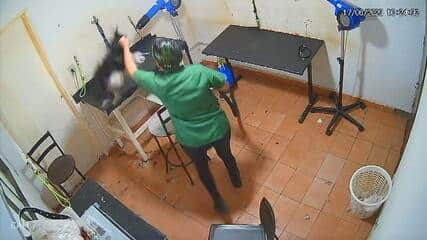
O vídeo mostra a cachorrinha tentando desesperadamente escapar dos maus-tratos, pulando da mesa. No entanto, ela é bruscamente puxada e jogada de volta ao local.
Após as agressões, Luma começou a apresentar sintomas preocupantes, levando seus tutores a levá-la imediatamente para atendimento de emergência. Apesar de todos os esforços, ela não resistiu e faleceu.

O exame necroscópico, realizado pela seção especializada em medicina veterinária legal da Polícia Científica de Goiás, confirmou que a causa da morte de Luma foi resultado direto das agressões sofridas.
Com informações de R7
The post Cachorrinha perde a vida depois de ser maltratada em pet shop em Goiânia appeared first on CONTI outra.